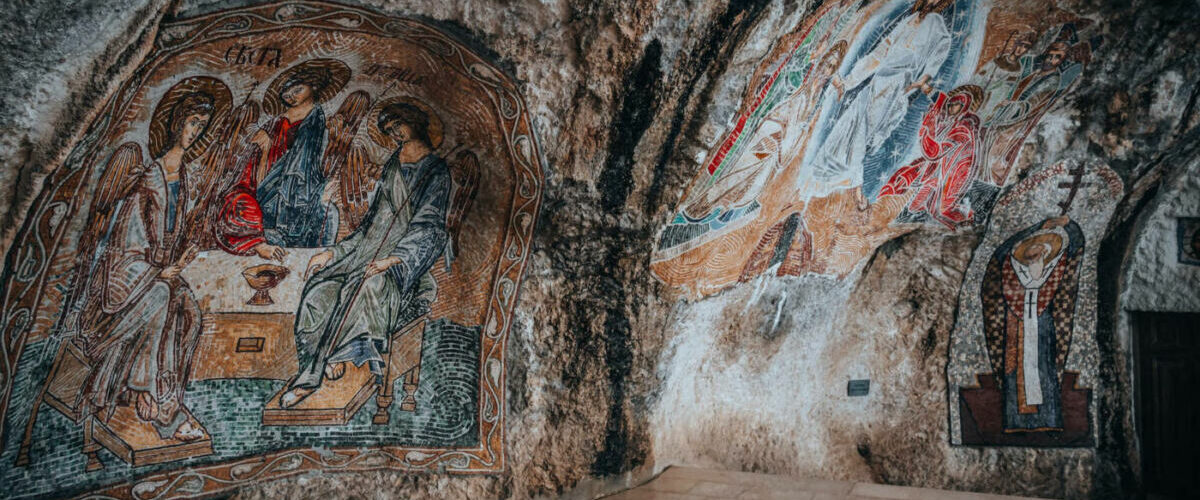It seems that the desire to create something beautiful appeared along with the birth of mankind. How else to explain the fact that our ancient ancestors created drawings of hunting scenes on the walls of their cave houses, which are the oldest art works? By the way, they were first discovered only in 1879 in the Altamira cave in Spain.
Later, archaeologists began to find ancient works of rock art and sculpture around the world – in Europe, and in Africa, and in Australia, and in both Americas. We decided to share with you stories about the oldest works of art that are currently known.
Ancient prehistoric works of art
Today, cupulas can be considered an example of the most ancient art – small depressions on the walls of caves in the form of cups. The domes were not arranged randomly, but in columns, and sometimes in rows on the rocks. Researchers find such bowls all over the world, and cupulas belong to different time periods. Even today, some tribes in Australia have a tradition of carving bowls on cave walls.
The oldest work of art of this kind was found in the caves of Bhimbetka in the heart of India. Here, the cupules remained intact and intact due to the ideal conditions prevailing in the caves. Archaeologists dated at least two of the cupulas found in the Bhimbetka cave to the early Paleolithic. Other works of art by ancient man discovered here have not been studied so carefully, but, most likely, they belong to the same period. Radiocarbon studies have yet to be done, but scientists already believe that these pictograms can be attributed to the Acheulean culture. The approximate age of these ancient works of art is about 290,000 years.
In the same part of India, in one of the Daraki-Chatan caves, 500 cupula pictograms were found, and with them a whole treasure trove of ancient stone tools. Darak Chatan is believed to contain the largest collection of prehistoric art of its kind. However, not all scientists agree that cupulas are works of art.
Probably, people used cupulas as mortars or poured water into them for some rituals. At least, modern representatives of some nationalities use cupulas in this way. But with a high degree of probability, these pictograms are still examples of ancient rock art. In addition, sometimes the cupules are located in such places that their rational use would be difficult.
The oldest oil painting
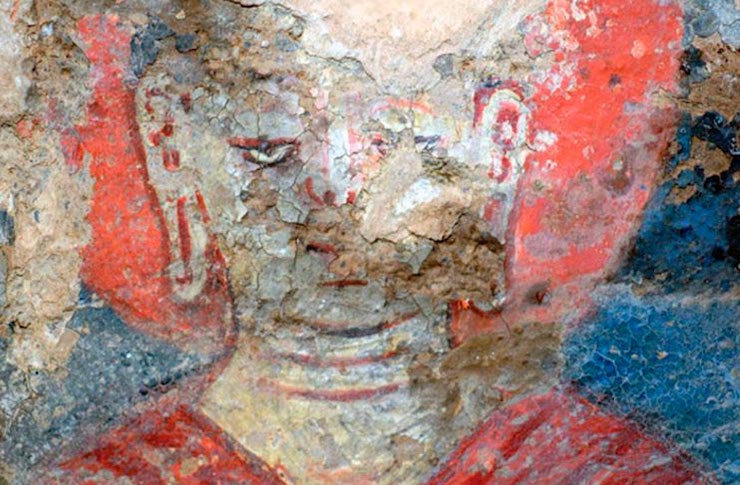
In 2008, a Buddhist fresco and several other paintings were discovered in the Afghan caves of Bamiyan. It would seem nothing strange. But after analyzing the paint and chemical tests, scientists found that it was oil-based. This made the find the oldest oil painting, dating back to the 7th century. It used to be thought that oil paintings began to be painted only in the 8th century.
In addition, traces of oil paint have been found on the remains of two Buddha statues in the caves of Bamiyan, as well as on other frescoes in these caves. Scientists believe that their study will provide valuable information about how, thanks to the Great Silk Road, there was a cultural exchange between the population of Western and East Asia.
The oldest Christian illuminated manuscript
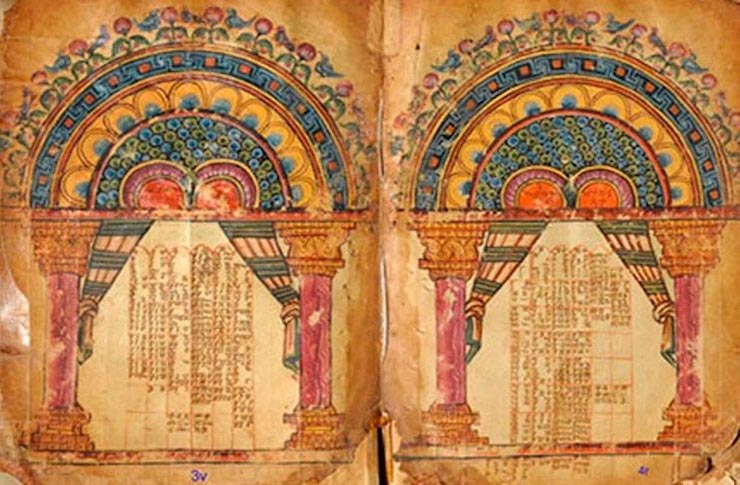
In the Middle Ages, books were considered incredibly valuable. There were few of them, and they were incredibly expensive. The covers of Christian scriptures were decorated with stones, and the pages used intricate calligraphy and bright colors to create illuminated manuscripts. Even medieval manuscripts and books have survived to this day very little, to say nothing of earlier editions. But not so long ago, archaeologists discovered a very, very ancient manuscript.
In 2010, in a closed monastery in Ethiopia, scientists found two scrolls – the Gospel of Garima. It is worth saying that at the very beginning, they considered that the scrolls were written around the 11th century. But a more thorough radiocarbon analysis revealed that the book is much older. It turned out that they wrote it approximately in 330-650.
There are many legends surrounding the Garima Gospel. For example, it is believed that its author is Isaac Garima, the founder of the monastery. According to legend, he wrote two Gospels in two days. And so that the saint could do this, God made it so that the Sun did not move across the sky.
The most ancient landscape
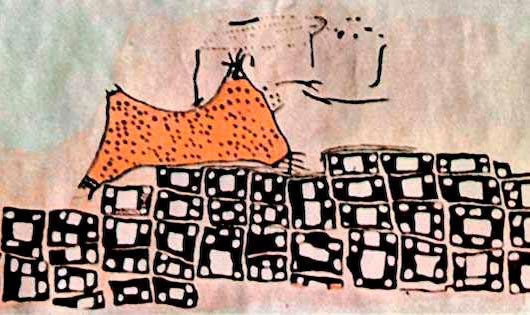
In 1963, archaeologist James Mellaart was involved in excavations at Katayholk, Turkey. It was there, on the territory of a large city of the Stone Age, that he found a fresco, which is most likely the oldest rock painting depicting a landscape. More precisely, Mellaart believed that on the fresco, called the Chatal fresco, an unknown artist presented a view of the city and the dwellings which looked like boxes. And in the background in this rock art is the Khasan Dag volcano. But other scientists disagree with him.
Some researchers suggest that Mellaart did not find an old landscape painting at all, but simply an abstract painting. According to them, the boxes in the rock art are just abstract forms, and the “volcano” is a drawing of a leopard skin. However, in 2013, there was some confirmation of the hypothesis of the archaeologist Mellaart. Studies have shown that about 6-8 thousand years ago in this region there really was an eruption of the Khasan Dag volcano, which the ancients could have depicted in a rock drawing. Only here in the world, there are other contenders for the title of the oldest landscape. This is Pavlov’s map dating back to 24-25 thousand years BC. e., and a map discovered in Western Europe. But those are maps, and Mellaart probably actually discovered the oldest landscape painting, which is a work of art by an ancient person.
The oldest handprints
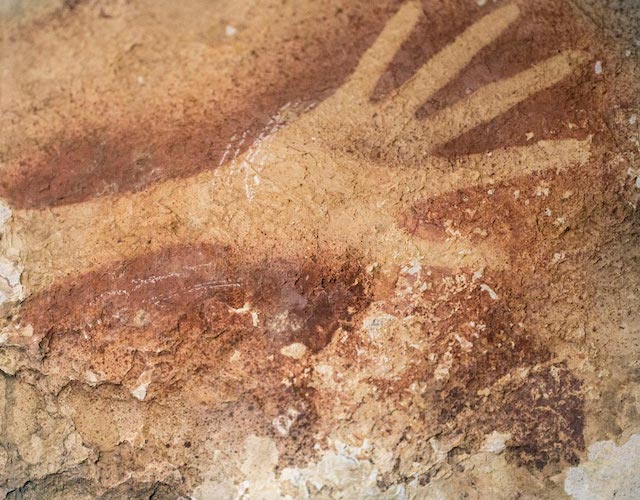
The rock art in the Indonesian cave of Sulawesi can be considered one of the oldest works of art. Its age is estimated at about 35,000 years, which puts it on par with such old rock paintings as those in El Castillo Cave and in the Seam Cave. Their age is 37,000 years and almost 41,000 years, respectively. And in the same Sulawesi cave, archaeologists noticed a very ancient example of prehistoric art.
On one of the walls of the cave, 12 handprints were found. Ancient people knew one curious way to transfer something to the plane of the wall. They applied the object to the wall, and then they blew ocher paint powder onto it from a thin tube. Thus, the imprint of the object was left on the wall, and the handprints in the Sulawesi cave are made in the same way. It is interesting that in contemporary art such a stencil method of leaving prints is actively used.
So far, scientists have determined the age of these drawings as about 40 thousand years. This became known thanks to the conducted radioisotope uranium study of the mineral coating on the sedimentary layer of the cave wall. If further study of the prints shows that they appeared before the sedimentary layer, then these rock paintings can be called the most truly ancient works of rock art.
The oldest rock art in Europe
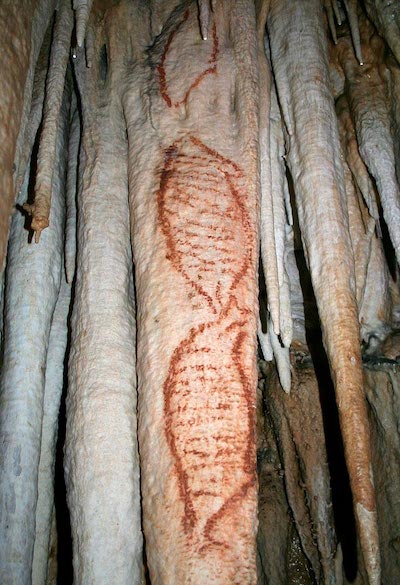
Not so long ago, it was believed that the ability of Neanderthals to create works of art tended to be zero. But in 2012, in the cave of Nehra in Spain, drawings were discovered that are older than representatives of the rock art of primitive people from the Chauvet cave. Charcoal found next to the drawings in Nehra allowed scientists to determine the approximate age of the drawings using radiocarbon dating. It turned out that they are approximately 42,300–43,500 years old. So what did our ancient ancestors depict in these drawings?
Neanderthals painted seals on the cave paintings in Nehra Cave. In those distant times, they were the main diet of people living in these places. In addition, the head of the study, José Luis Sanchidrian, noted that this rock art does not have any parallels with other drawings of the Paleolithic era.
The oldest image on the shell of eggs
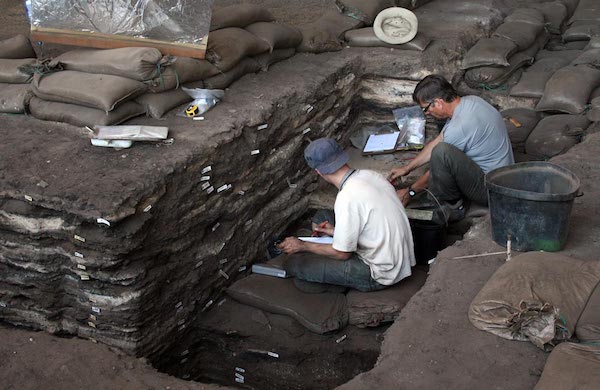
Representatives of many ancient cultures made carvings or drawings on the shell of ostrich eggs. We can say that this was one of the very first ways of self-expression of our ancient ancestors. In 2010, archaeologists found probably one of the oldest works of art of its kind.
In 2010, during excavations in the South African cave of Dipkloof, a real treasure was discovered. It consisted of 270 fragments of ostrich egg shells, on which drawings have been preserved. Most of them are made on the theme of hatching a chick from an egg, and they were applied to the shell by engraving or using various pigments. The motifs of other designs consisted of converging or parallel lines applied next to the hatched stripes. This discovery allowed scientists to establish the existence of traditional patterns among the representatives of mankind who lived in the Stone Age.
In addition, round holes carved by man were found in fragments of eggshells found in Dipklof. Thanks to this, scientists came to the conclusion that empty ostrich eggs were used as ordinary vessels for water or other liquid.
The oldest stone sculpture
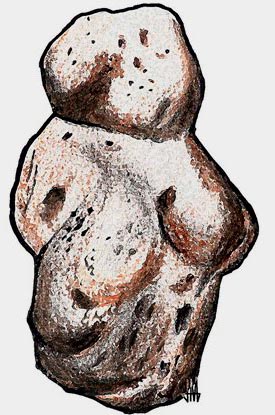
The most ancient sculpture, whose authenticity and dating are beyond doubt, is the Swabian Venus, or Venus from Hole Fels. Its age is about 40,000 years. However, not so long ago, archaeologists discovered an older sculpture.
The sculpture, probably made before the advent of the Neanderthals, was discovered in Israel and dubbed Venus from Berehat Ram. They found it between a layer of earth and a layer of volcanic stone, whose ages range from 230 thousand to 800 thousand years BC. e. At first, Venus from Berehat-Ram was simply mistaken for a stone that only looked like a human figure. However, when the researcher Alexander Marshak conducted a more thorough analysis, he found clear signs on the stone that it had been processed by a person. In addition, the base of the sculpture is absolutely flat, which means that it could be used for ritual purposes.
Similar works of art by ancient man were found in Morocco. For example, the age of the figurine of Venus from Tan-Tan, very similar to the sculpture of Venus from Berehat-Rama, which scientists have estimated at 300-500 thousand years. Traces of brownish-yellow paint have been preserved on it, which indicates that this statuette was used for ceremonial purposes.
The oldest ivory figurine
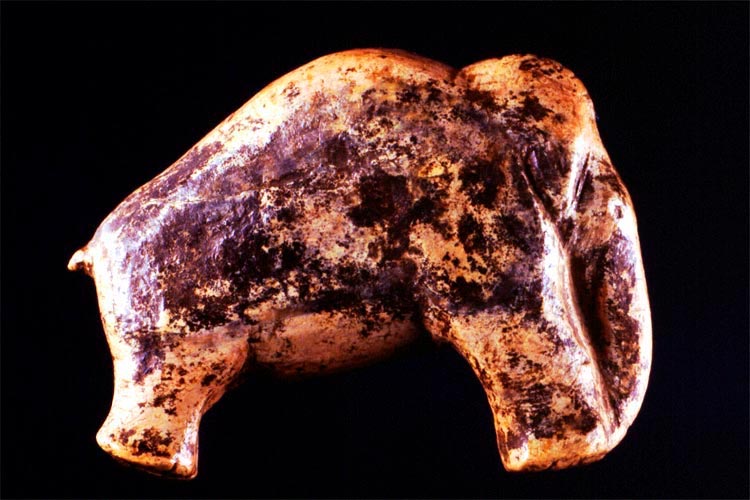
In 2007, a group of archaeologists from the University of Tübingen carried out excavations in the caves of the Swabian Alb. There they discovered several figurines made of elephant bone, whose age, according to approximate estimates, was 35 thousand years.
Five ivory figurines were found in the caves of Vogelherd, and their analysis by radiocarbon method showed that they were approximately 30-60 thousand years old. It is likely that these figurines were made by representatives of the Aurignacian culture. By the way, they are considered the first group of modern people who came to Europe. And in 2009, in the same region, archaeologist Nicholas J. Conard found three figurines dating from the same period. It is noteworthy that among them were a bone figurine of a bird, a figurine similar to a horse, and a therianthropic figurine depicting a half human, half animal.
By the way, other interesting finds were found in the caves in the south-west of Germany. In particular, the figurine of a man-lion from the Hochlenstein Stadel and Venus from Hole Fels also called the Swabian Venus.
Ancient ceramic sculpture
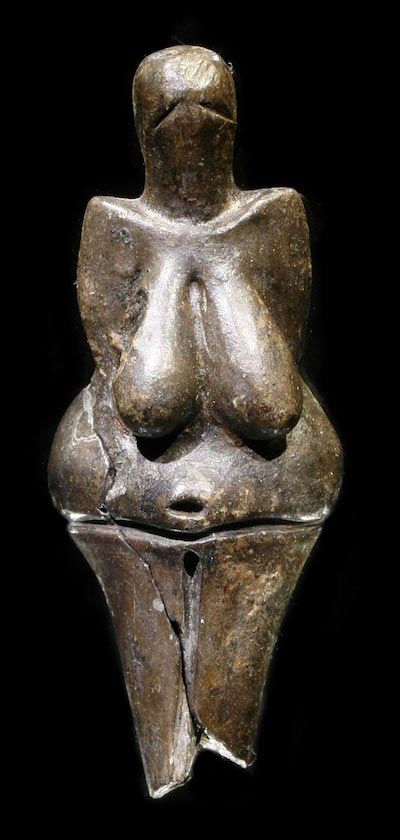
The Vestonice Venus bears a resemblance to many statuettes of Venus found all over the Earth. This is a small (only 11.3 cm) figurine with huge breasts and large buttocks, and on her face, there are two slits symbolically depicting eyes. They found her in South Moravia in July 1925. Vestonice Venus was the first ceramic sculpture made entirely of clay, fired at low temperatures.
The Vestonice Venus is about 27,000 years old, which means that it was born long before, according to scientists, people mastered the manufacture of ceramics. Studies have shown that the Vestonice Venus figurine was fired at 700 degrees Celsius. They attributed it to the Gravetian culture that existed 22–28 thousand years ago. Its representatives were familiar with the firing of clay, but their knowledge was probably subsequently lost. Scientists have not found similar ceramic figures of a later period in that region of Czechoslovakia. But in 2002, something interesting was found on Vestonica Venus.
In addition to the fact that four small holes on the head were found on the ceramic sculpture. In which flowers or incense were placed, a fingerprint was found on it. And it obviously belonged to a child of 7-15 years old. It is not known for sure whether the child created the Vestonica Venus. But even if he did not, he clearly helped the creator. This means that in the Gravetic culture, the elders passed on their knowledge to the younger ones.
The oldest wooden statue
Ancient bone figurines have survived to this day because their material is less affected by time and weather conditions. But the ancient wooden figures can be counted on the fingers. So, the idols of the Slavic gods, carved from wood, practically did not reach the present. Except for one – the Shigir idol.
The Shigir idol was found in the Middle Urals, not far from Yekaterinburg. The larch sculpture lay for a long time in a peat bog at a depth of four meters, which allowed it to be perfectly preserved. After analyzing the wood, scientists found that it was created in the Mesolithic era, that is, about 8000-9500 years ago. Also, at the place of discovery of this wooden idol, many bones and various objects made of clay were found.
Initially, the Shigir idol, according to the assumptions of modern scientists, was about five meters high. But several fragments were found in the peat bog. Which for a long time could not be connected with each other. Collecting the idol in random order shortly after its discovery in 1890, the scientists obtained a figure 2.8 meters high. It was only in 1914 that reconstruction was carried out using all the fragments found. And that’s when everything fell into place. The Shigir idol rose 5.3 meters above the floor. But in the turmoil of the revolution, some of its parts were lost, and now its height is 3.4 meters. The Shigir idol is probably the oldest piece of ancient wood carving art in the world.
